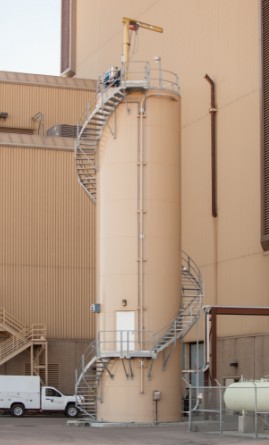Mercury emissions control

Rawhide uses Powder River Basin sub-bituminous coal. During coal combustion, trace mercury compounds in the coal are either vaporized as elemental mercury, chemically converted into gaseous oxidized mercury compounds or chemically bound with particulate matter. These forms of mercury represent an extremely small (parts per trillion) percentage of the flue gas.
The State of Colorado implemented its Utility Mercury Reduction Regulation, specifying mercury emission rate limits that became effective for Rawhide in 2012, then lowered the rates in 2018. The EPA Mercury and Air Toxics Standard (MATS), which became effective in 2015, required additional mercury reductions. In advance of these regulatory mandates, Platte River, in 2010, installed a state-of-the-art mercury control system that uses brominated powdered activated carbon (B-PAC) injection (ACI) technology. A continuous mercury monitoring system meets the state’s monitoring requirements and demonstrates compliance with all regulatory requirements.
The ACI system injects the B-PAC into the flue gas upstream from the SO2 control system. The bromide in the B-PAC reacts with elemental mercury to produce an oxidized compound which is more easily absorbed by the activated carbon particles. After absorbing mercury, the B-PAC is collected in the particulate control system baghouses along with ash and other particulates. Additional mercury is removed while the B-PAC is present on the surface of the fiberglass bag filters.
Particulate emissions control
During coal combustion and sulfur dioxide (SO2) emissions control operations, ash and other particulate materials are produced by Rawhide Energy Station Unit 1 that must be removed from the flue gas before being discharged at the plant stack. The Rawhide operating permit issued by the state of Colorado limits the particulate emission rate and requires greater than 99.9% of these particulates be removed using a baghouse control system.
The system consists of two baghouses where the particulate is filtered from the flue gas using 34-foot-long, 12-inch-diameter Teflon®-coated fiberglass bag filters. Each baghouse contains 3,276 bag filters separated into 12 compartments. The compartments are periodically cleaned by reversing the air flow through the bag filters and the collected particulate beneficially used by other industries or disposed of in Rawhide’s on site monofill.
Sulphur dioxide (SO2) emissions control
Rawhide uses low-sulfur Powder River Basin subbituminous coal. During coal combustion the trace sulfur compounds in the coal are converted to SO2, which must be removed from the flue gas before being discharged from the plant stack. The Rawhide operating permit issued by the state of Colorado limits the SO2 emission rate and requires that at least 80% of the SO2 is removed.
The plant controls SO2 emissions by using a spray dryer absorber (SDA) flue gas desulfurization system. In the SDA process, hot flue gas passes through large reaction chambers where a lime-water slurry (calcium hydroxide) is sprayed and atomized. The calcium hydroxide in the atomized slurry reacts with the SO2 in the flue gas to produce calcium sulfate and calcium sulfite. The hot flue gas evaporates water from the slurry and cools to produce a dry particulate material composed of calcium sulfate, calcium sulfite and unreacted calcium oxide (lime). This residual is captured in the bag house along with the ash and disposed of in the onsite monofill or transferred offsite for beneficial use.
Unit 1 performs among the lowest SO2-emitting coal-fired plants in the U.S. according to data available from the U.S. Environmental Protection Agency.